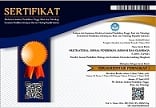Aktivitas fisik, perilaku menetap, dan perilaku merokok pada calon guru pendidikan jasmani-sebuah studi cross-sectional
Abstract
Perilaku tidak sehat seperti kurang aktivitas fisik, perilaku menetap, dan merokok menyebabkan peningkatan risiko kematian. Penelitian ini berusaha untuk mengidentifikasi korelasi aktivitas fisik dan perilaku menetap di antara calon guru Pendidikan jasmani di Program Studi Pendidikan Jasmani dan Kesehatan, FKIP, Universitas Sriwijaya, serta menyelidiki perbedaan pola aktivitas fisik mereka dengan status merokok. Peserta (n= 380) diukur tingkat aktivitas fisik dan perilaku menetap diukur dengan menggunakan kuesioner International Physical Activity Questionaire–Short Form (IPAQ-SF) yang memiliki spesifikasi digunakan untuk responden 15 tahun ke atas dan dianalisis berdasarkan pedoman IPAQ-SF. Sedangkan untuk data kebiasaan merokok, instrumen yang digunakan adalah Glover-Nilsson Smoking Behavioral Questionnaire (GN-SBQ). Analisis chi-square dilakukan untuk menguji perbedaan dalam aktivitas fisik dengan status merokok, dan analisis regresi untuk menghasilkan korelasi sosiodemografi dari memenuhi pedoman aktivitas fisik (seperti yang direkomendasikan oleh Organisasi Kesehatan Dunia) dan perilaku menetap. Mengingat tingginya prevalensi aktivitas fisik yang tidak memadai dan perilaku menetap yang berlebihan saat ini, sebelumnya, dan non-perokok, program yang ditujukan untuk meningkatkan aktivitas fisik dan menurunkan tingkat perilaku menetap harus diintegrasikan ke dalam rencana perkuliahan yang ditargetkan untuk meningkatkan aktivitas fisik calon guru Pendidikan Jasmani.
Keywords
References
Canning, K. L., Brown, R. E., Jamnik, V. K., Salmon, A., Ardern, C. I., & Kuk, J. L. (2014). Individuals underestimate moderate and vigorous intensity physical activity. PLoS ONE, 9(5), e97927. https://doi.org/10.1371/journal.pone.0097927
CDC. (2017). Health Effects of Cigarette Smoking. Centers for Disease Control and Prevention. https://www.cdc.gov/tobacco/data_statistics/fact_sheets/health_effects/effects_cig_smoking/index.htm
CDC. (2021). Respiratory Care Settings and Smoking Cessation: Smoking and Tobacco Use. https://www.cdc.gov/tobacco/patient-care/care-settings/respiratory/index.htm
Colberg, S. R., Sigal, R. J., Yardley, J. E., Riddell, M. C., Dunstan, D. W., Dempsey, P. C., Horton, E. S., Castorino, K., & Tate, D. F. (2016). Physical activity/exercise and diabetes: A position statement of the American Diabetes Association. Diabetes Care, 39(11), 2065–2079. https://doi.org/10.2337/dc16-1728
Dėdelė, A., Miškinytė, A., Andrušaitytė, S., & Nemaniūtė-Gužienė, J. (2019). Seasonality of physical activity and its association with socioeconomic and health factors among urban-dwelling adults of Kaunas, Lithuania. BMC Public Health, 19(1), 1067. https://doi.org/10.1186/s12889-019-7399-4
Foulds, H. J. A., Bredin, S. S. D., Charlesworth, S. A., Ivey, A. C., & Warburton, D. E. R. (2014). Exercise volume and intensity: a dose–response relationship with health benefits. European Journal of Applied Physiology, 114(8), 1563–1571. https://doi.org/10.1007/s00421-014-2887-9
Garcia-Aymerich, J., Lange, P., Benet, M., Schnohr, P., & Antó, J. M. (2007). Regular Physical Activity Modifies Smoking-related Lung Function Decline and Reduces Risk of Chronic Obstructive Pulmonary Disease. American Journal of Respiratory and Critical Care Medicine, 175(5), 458–463. https://doi.org/10.1164/rccm.200607-896OC
García-Fernández, González-López, Vilches-Arenas, & Lomas-Campos. (2019). Determinants of Physical Activity Performed by Young Adults. International Journal of Environmental Research and Public Health, 16(21), 4061. https://doi.org/10.3390/ijerph16214061
Gibson, K. M. (2017). Physical activity. Integrating Nutrition into Practice. https://doi.org/10.1542/9781581105322-ch03
Grumelli, S., Corry, D. B., Song, L. Z., Song, L., Green, L., Huh, J., Hacken, J., Espada, R., Bag, R., Lewis, D. E., & Kheradmand, F. (2004). An immune basis for lung parenchymal destruction in chronic obstructive pulmonary disease and emphysema. In PLoS Medicine (Vol. 1, pp. 075–083). Centers for Disease Control and Prevention (US). https://doi.org/10.1371/journal.pmed.0010008
Guthold, R., Stevens, G. A., Riley, L. M., & Bull, F. C. (2018). Worldwide trends in insufficient physical activity from 2001 to 2016: a pooled analysis of 358 population-based surveys with 1•9 million participants. The Lancet Global Health, 6(10), e1077–e1086. https://doi.org/10.1016/S2214-109X(18)30357-7
Heydari, G., Hosseini, M., Yousefifard, M., Asady, H., Baikpour, M., & Barat, A. (2015). Smoking and Physical Activity in Healthy Adults: A Cross-Sectional Study in Tehran. Tanaffos, 14(4), 238–245. http://www.ncbi.nlm.nih.gov/pubmed/27114725
Hupin, D., Roche, F., Gremeaux, V., Chatard, J.-C. C., Oriol, M., Gaspoz, J.-M. M., Barthélémy, J.-C. C., & Edouard, P. (2015). Even a low-dose of moderate-to-vigorous physical activity reduces mortality by 22% in adults aged ≥60 years: a systematic review and meta-analysis. British Journal of Sports Medicine, 49(19), 1262–1267. https://doi.org/10.1136/bjsports-2014-094306
Jung, M. E., Bourne, J. E., & Little, J. P. (2014). Where does HIT fit? an examination of the affective response to high-intensity intervals in comparison to continuous moderate- And continuous vigorous-intensity exercise in the exercise intensity-affect continuum. PLoS ONE, 9(12), e114541. https://doi.org/10.1371/journal.pone.0114541
Kang, M., & Rowe, D. A. (2015). Issues and Challenges in Sedentary Behavior Measurement. Measurement in Physical Education and Exercise Science, 19(3), 105–115. https://doi.org/10.1080/1091367X.2015.1055566
Kurtze, N., Rangul, V., & Hustvedt, B. E. (2008). Reliability and validity of the international physical activity questionnaire in the Nord-Trøndelag health study (HUNT) population of men. BMC Medical Research Methodology, 8, 63. https://doi.org/10.1186/1471-2288-8-63
Merrill, R. M. (2020). Leisure-Time Physical Inactivity’s Association With Environmental, Demographic, and Lifestyle Factors in the United States. Journal of Physical Activity and Health, 17(4), 412–422. https://doi.org/10.1123/jpah.2018-0522
Myers, J., McAuley, P., Lavie, C. J., Despres, J. P., Arena, R., & Kokkinos, P. (2015). Physical Activity and Cardiorespiratory Fitness as Major Markers of Cardiovascular Risk: Their Independent and Interwoven Importance to Health Status. Progress in Cardiovascular Diseases, 57(4), 306–314. https://doi.org/10.1016/j.pcad.2014.09.011
Paterson, D. H., & Warburton, D. E. R. (2010). Physical activity and functional limitations in older adults: A systematic review related to Canada’s Physical Activity Guidelines. International Journal of Behavioral Nutrition and Physical Activity, 7(1), 38. https://doi.org/10.1186/1479-5868-7-38
Rath, J. M., Sharma, E., & Beck, K. H. (2013). Reliability and validity of the Glover-Nilsson smoking behavioral questionnaire. American Journal of Health Behavior, 37(3), 310–317. https://doi.org/10.5993/AJHB.37.3.3
Roberts, V., Maddison, R., Simpson, C., Bullen, C., & Prapavessis, H. (2012). The acute effects of exercise on cigarette cravings, withdrawal symptoms, affect, and smoking behaviour: systematic review update and meta-analysis. Psychopharmacology, 222(1), 1–15. https://doi.org/10.1007/s00213-012-2731-z
Safiyari-Hafizi, H., Taunton, J., Ignaszewski, A., & Warburton, D. E. R. (2016). The Health Benefits of a 12-Week Home-Based Interval Training Cardiac Rehabilitation Program in Patients With Heart Failure. Canadian Journal of Cardiology, 32(4), 561–567. https://doi.org/10.1016/j.cjca.2016.01.031
Schuch, F., Vancampfort, D., Firth, J., Rosenbaum, S., Ward, P., Reichert, T., Bagatini, N. C., Bgeginski, R., & Stubbs, B. (2017). Physical activity and sedentary behavior in people with major depressive disorder: A systematic review and meta-analysis. Journal of Affective Disorders, 210, 139–150. https://doi.org/10.1016/j.jad.2016.10.050
Stubbs, B., Vancampfort, D., Hallgren, M., Firth, J., Veronese, N., Solmi, M., Brand, S., Cordes, J., Malchow, B., Gerber, M., Schmitt, A., Correll, C. U., De Hert, M., Gaughran, F., Schneider, F., Kinnafick, F., Falkai, P., Möller, H.-J. J., & Kahl, K. G. (2018). EPA guidance on physical activity as a treatment for severe mental illness: a meta-review of the evidence and Position Statement from the European Psychiatric Association (EPA), supported by the International Organization of Physical Therapists in Mental. European Psychiatry, 54, 124–144. https://doi.org/10.1016/j.eurpsy.2018.07.004
Vancampfort, D., Firth, J., Schuch, F. B., Rosenbaum, S., Mugisha, J., Hallgren, M., Probst, M., Ward, P. B., Gaughran, F., De Hert, M., Carvalho, A. F., & Stubbs, B. (2017). Sedentary behavior and physical activity levels in people with schizophrenia, bipolar disorder and major depressive disorder: a global systematic review and meta-analysis. World Psychiatry, 16(3), 308–315. https://doi.org/10.1002/wps.20458
Warburton, D. E. R., & Bredin, S. S. D. (2017). Health benefits of physical activity. Current Opinion in Cardiology, 32(5), 541–556. https://doi.org/10.1097/HCO.0000000000000437
Warburton, D. E. R., Bredin, S. S. D., Jamnik, V., Shephard, R. J., & Gledhill, N. (2016). Consensus on evidence-based preparticipation screening and risk stratification. Annual Review of Gerontology and Geriatrics, 36(1), 53–102. https://doi.org/10.1891/0198-8794.36.53
Warburton, D. E. R., Charlesworth, S., Ivey, A., Nettlefold, L., & Bredin, S. S. D. (2010). A systematic review of the evidence for Canada’s Physical Activity Guidelines for Adults. International Journal of Behavioral Nutrition and Physical Activity, 7(1), 39. https://doi.org/10.1186/1479-5868-7-39
WHO. (2008). A Policy Package To Reverse The Tobacco Epidemic. Policy. https://www.who.int/tobacco/mpower/mpower_english.pdf
WHO. (2020a). COVID-19 advice - High risk groups | WHO Western Pacific. World Health Organisation. https://www.who.int/westernpacific/emergencies/covid-19/information/high-risk-groups
WHO. (2020b). Physical Activity. https://www.who.int/news-room/fact-sheets/detail/physical-activity
World Health Organization. (2021). WHO Coronavirus Disease (COVID-19) Dashboard With Vaccination Data | WHO Coronavirus (COVID-19) Dashboard With Vaccination Data. World Health Organization. https://covid19.who.int/%0Ahttps://covid19.who.int/%0Ahttps://covid19.who.int/region/searo/country/bd
DOI: http://dx.doi.org/10.20527/multilateral.v21i3.14519
Article Metrics
Abstract view : 680 timesPDF - 324 times Similarity Check - 113 times
Refbacks
- There are currently no refbacks.
Copyright (c) 2022 Multilateral : Jurnal Pendidikan Jasmani dan Olahraga

This work is licensed under a Creative Commons Attribution-ShareAlike 4.0 International License.
Tools:
Indexed by:

Multilateral : Jurnal Pendidikan Jasmani dan Olahraga is licensed under a Creative Commons Attribution-ShareAlike 4.0 International License.

















